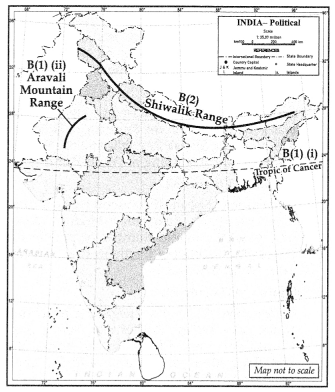Students must start practicing the questions from CBSE Sample Papers for class 9 Social Science with Solutions Set 2 are designed as per the revised syllabus.
CBSE Sample Papers for Class 9 Social Science Set 2 with Solutions
Time Allowed: 3 hours
Maximum Marks: 80
General Instructions:
- Question paper comprises five Sections -A, B, C, D, and E. There are 37 questions in the question paper. All questions are compulsory.
- Section A – From questions 1 to 20 are MCQs of 1 mark each.
-
Section B – Questions no. 21 to 24 are Very Short Answer Type Questions, carrying 2 marks each. The answer to each
question should not exceed 40 words. - Section C – Questions no. 25 to 29 are Short Answer Type Questions, carrying 3 marks each. The answer to each question should not exceed 60 words.
- Section D – Questions no. 30 to 33 are Long Answer Type Questions, carrying 5 marks each. Answer to each question should not exceed 120 words.
- Section E – Questions no. from 34 to 36 are Case Based Questions with three sub-questions and are of 4 marks each.
-
Section F – Question no. 37 is Map based, carrying 5 marks with two parts, 37a from History (2 marks) and 37b from
Geography (3 marks). - There is no overall choice in the question paper. However, an in terna! choice has been provided in a few questions. Only one of the choices in such questions has to be attempted.
- In addition to this, separate instructions are given with each section and question, wherever necessary.
Section-A
MCQs
(1 x 20 = 20 Marks)
Question 1.
The city of Paris is located in: [1]
(A) Italy
(B) England
(C) France
(D) Portugal
Answer:
Option (C) is correct.
Explanation: it is the capital city of France and a global center of culture. During the Middle Ages, it was the major city of Europe and at the same time, its name was changed to Paris. Its original name was Lutetia.
Question 2.
Which country had an absolute monarchy before 1857? [1]
(A) France
(B) India
(C) Both
(D) Neither
Answer:
Option (A) is correct.
Explanation: France had an absolute monarchy before 1857. The Bourbon king of France, Louis XVI, was an extremely autocratic and weak-willed king who led a life of absolute luxury.
Question 3.
Study the figure carefully and answer the question that follows:
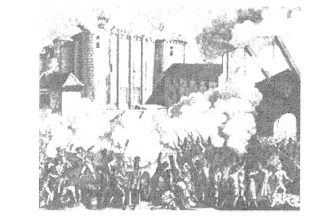
Which of the following options best signifies this cartoon? [1]
(A) Demolition of Bastille
(B) Democracy of People
(C) People revolt against the king
(D) None of these
Answer:
Option (A) is correct. (1)
Explanation: This is a picture of the demolition or storming of the Bastille which took place on 14th July 1789.
Question 4.
‘Sarva Shiksha Abhiyan’ is a significant step towards providing elementary education to all children in the age group of ………………. . [1]
(A) 6-12
(B) 6-10
(C) 8-14
(D) 6-14
Answer:
Option (C) is correct.
Explanation: It is a program me launched by the Indian government which is aimed at universalisa bon of elementary education.
Question 5.
What does the term holocaust mean? [1]
(A) Mass murder of Jews by Nazis
(B) Group of German Nazis
(C) Group of Jews
(D) Deporting people to gas chambers
Answer:
Option (A) is correct.
Explanation: The term holocaust means the persecution and mass murder of Jews by German Nazis between 1933 and 1945.
Question 6.
In which year Hitler became the President of Germany? [1]
(A) 1933
(B) 1936
(C) 1934
(D) 1938
Answer:
Option (C) Is correct.
Explanation: In 1933, Hitler was made Chancellor of Germany. He pulled out of the League of Nations. In 1934, Hitler became the president of Germany. In 1938, the integration of Germany and Austria by Hitler.
Question 7.
A statement of Assertion (A) is followed by a statement of Reason (R). Mark the correct choice
Assertion (A): China is a democratic country.
Reason (R): In China, elections are regularly held after every five years for electing the country’s parliament
(A) Both Assertion (A) and Reason (R) are true, and Reason (R) is the correct explanation of Assertion (A).
(B) Both Assertion (A) and Reason (R) are true, but Reason (R) is not the correct explanation of Assertion (A).
(C) Assertion (A) is true, but Reason (R) is false.
(D) Asserhon (A) is false, hut Reason (R) is true.[1]
Answer:
Option (D) is correct.
Explanation: Though the elections are held regularly in China, it is not a democratic country. China is a communist country. Like other democratic countries, any other political party cannot participate in the elections of China. The party must be affiliated to the Communist Party 0f China to participate in the elections
Question 8.
What is the easternmost longitude of India? [1]
(A) 97°25’N
(B) 97°25’E
(C) 97°25’W
(D) 97°25’S
Answer:
Option (B) is correct.
Explanation: The easternmost longitude of India is 97°25’E It is based in Arunachal Pradesh.
Question 9.
There are two statements marked as Assertion (A) and Reason (R). Read the statements and choose the correct option.
Assertion (A): An educated society has direct and indirect advantages.
Reason (R): Educated and healthier people gain higher incomes
(A) Both Assertion (A) and Reason (R) are true and Reason (R) is the correct explanation of Assertion (A).
(B) Both Assertion (A) and Reason (R) are true and Reason (R) is not the correct explanation of Assertion (A).
(C) Assertion (A) is correct but Reason (R) is wrong.
(D) Assertion (A) is wrong but Reason (R) is correct. [1]
Answer:
(B) Both Assertion (A) and Reason (R) are true and Reason (R) is not the correct explanation of Assertion (A).
Question 10.
Which country shares the longest boundary with India? [1]
(A) SriLanka
(B) Bangladesh
(C) China
(D) Myanmar
Answer:
Option (B) is correct.
Explanation: India shares its land boundary with seven countries. Among all the above options. the length of the Bangladesh-India border is 4096.7 km.
Question 11.
Which of the following is the poorest state? [1]
(A) Punjab
(B) Bihar
(C) Haryana
(D) Himachal Pradesh
Answer:
Option (B) is correct.
Explanation: Bihar is the poorest state with a poverty ratio of 33.7 percent.
Question 12.
The magnitude of population growth refers to: [1]
(A) the total population of an area.
(B) the number of persons added each year.
(C) the rate at which the population increases.
(D) the number of females per thousand males.
Answer:
Option (B) is correct.
Explanation: The absolute numbers added each year or decade are the magnitude of the increase. It is obtained by simply subtracting the earlier population from the later population.
Question 13.
What is India’s share of the World’s Area and Population? [1]
(A) 2.4% and 17.5%
(B) 17.5% and 2.4%
(C) 2.4% and 17.5%
(D) 97.6% and 82.5%
Answer:
Option (C) is correct.
Explanation: India’s share of the world’s area is 2.4 percent while India’s share of the world’s population is 17.5 percent.
Question 14.
Study the data carefully and answer the following questions:
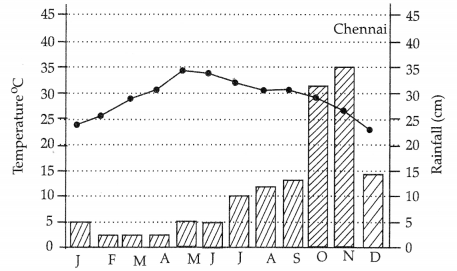
Chennai recorded the highest temperature and highest rainfall in the months of ……………. and …………………. .[1]
(A) June, November
(B) May, December
(C) May, November
(D) June, December
Answer:
Option (A) is correct.
Explanation: May has an average maximum temperature of 37°C (99°F) and is the warmest month of the year in Chennai. Chennai receives most of its rain from northeast and retreating monsoons during November. Moreover, many low-pressure systems develop in the Bay of Bengal during this period and move towards the east coast of Tamil Nadu causing heavy rainfall.
Question 15.
Which of these is a non-democratic country? [1]
(A) USA.
(B) Africa
(C) India
(D) Pakistan
Answer:
Option (D) is correct
Explanation: Pakistan has a federal parliamentary republic type of government.
Question 16.
On what does the fate of a democratic country mainly depend? [1]
(A) Constitution
(B) Politicians
(C) What we as responsible citizens do
(D) Foreign policies
Answer:
Option (C) is correct
Explanation: Citizens have a responsibility to participate in their government by registering to vote and voting in elections. By voting, citizens have a voice in their government and help ensure that the democratic representative system of government is maintained. Hence, the role of citizens is vital for the success of democracy.
Question 17.
How are laws created and enforced in India? [1]
(A) By the Prime Minister
(B) By the President
(C) By the Parliament
(D) By the military
Answer:
Option (C) is correct. [11
Explanation: The Parliament is a national assembly of elected representatives of the people. The Parliament has the authority of enacting laws. It can add new laws, and change or abolish existing laws. National policy and important public issues are discussed and debated in the Parliament.
Question 18.
Who advocated that India would be truly independent only when the poorest of its people become free of human suffering? [1]
(A) Mahatma Gandhi
(B) Indira Gandhi
(C) Rajeev Gandhi
(D) B.R. Ambedkar
Answer:
Option (A) is correct. [1]
Explanation: Mahatma Gandhi advocated that India would be truly independent only when the poorest of its people become free of human suffering. Mahatma Gandhi was an Indian lawyer and political ethicist. He was known as the Father of the Nation.
Question 19.
Which of the following groups in India does not suffer from food insecurity? [1]
(A) Farmers
(B) Landlords
(C) Illiterates
(D) All of these
Answer:
Option (B) is correct.
Explanation: Landlords do not suffer from food insecurity because they have high incomes.
Question 20.
Which organisation maintains buffer stock in India? [1]
(A) Indian Food Corporation
(B) Food Corporation
(C) Food Corporation of India (FCI)
(D) None of these.
Answer:
Option (C) is correct.
Explanation: Buffer Stock is the stock of food grains, namely wheat and rice procured by the Government through Food Corporation of India (FCI). The FCI purchases wheat and rice from the farmers in states where there is surplus production.
Section-B
Very Short Answer Questions
(2 x 4 = 8 Marks)
Question 21.
Why was centralised planning introduced in Russia? Describe the economic condition of the workers at the beginning of the twentieth century. [2]
Answer:
Centralised planning was introduced in Russia on the basis of which the government made the Five-Year Plans. The government fixed all prices to promote industrial growth during the first two ‘Plans’. (1927- 1932 and 1933-1938). Centralised planning led to economic growth. Industrial production increased (between 1929 and 1933 by 100 percent in the case of oil, coal, and steel). New factory cities came into being.
- Most industry was the private property of industrialists
- Most of the workers were working for about 10 to 12 hours, a day.
- The working conditions were also very poor.
- Women workers made up about 31% of the factory labour, but they were pair less than men. [2]
Question 22.
What do the civil and criminal courts deal with? [2]
Answer:
- The civil courts deal with general disputes regarding land, property, and rights.
- The criminal courts deal with cases of murder, riot and looting.
Question 23.
How can food security be ensured in a country? [2]
Answer:
The food security is ensured in a country only if:
- Enough food is available for all the people, i.e., no person should die because of hunger. Everyone should get enough food for their livelihood.
- Everyone has the capacity to buy food. Food should be available to all, i.e., it should not be so expensive that it becomes difficult for a person to buy it.
- Food should be accessible to all ignoring all the barriers of rich and poor classes, etc.
Question 24.
India has a single integrated judicial system. Explain the structure. [2]
Answer:
The Indian judiciary consists of a Supreme Court for the entire nation, High Courts in the states, District Courts, and the courts at the local level.
Section-C
Short Answer-Based Questions
(3 x 5 = 15 Marks)
Question 25.
Explain Lenin’s ‘April Theses’. What were its effects on the party members? [3]
Answer:
Demands of ‘April Theses’:
- Lenin returned to Russia from exile and felt that it was time for the Soviets to take over power. He declared that war be brought to a dose, land be transferred to the peasants, and banks nationalised. He also argued to rename Bolshevik Party as Communist Party.
- Started planning on the uprising against the government with the support of the army.
- Military Revolutionary Committee was planned to seize the power and bring the city under control.
- Initially, the members were surprised and thought that the rime was not right for Socialist Revolution, but the developments in the subsequent months changed their attitude.
Question 26.
What is meant by Indian Standard Time? Why do we need a Standard Meridian for India?
OR
Why is Indian Ocean named after our country? Give three reasons. [3]
Answer:
The time applicaNe all over India is Indian Standard Time. To avoid a time gap of 2 hours between the East and West parts of India which may create confusion in working, it is essential to have a Standard Meridian.
- India has the longest coastline on the Indian Ocean.
- India has a central location between East and West Asia.
- Indias Southernmost extension Deccan Peninsula protrudes into Indian Ocean that makes it significant to international trade done through Indian Ocean.
Question 27.
‘Popular governments can also be undemocratic.’ Justify the statement by giving a suitable example. [3]
Answer:
- In Zimbabwe, opposition party workers harassed the other party workers and disrupted their meetings.
- Public protests against the government were declared illegal.
- There is a law that limits the right to criticise the President.
Question 28.
What are the most effective ways to stimulate economic growth and create more jobs? [3]
Answer:
Some effective ways to stimulate economic growth and create more jobs include investing in education and training programmes, promoting international trade, encouraging entrepreneurship, creating public works programmes, increasing public sector employment, implementing a living wage, and addressing discrimination and inequality.
Question 29.
“In poor families, all suffer, but some suffer more than others.” Explain the statement. [3]
Answer:
Analysis of poverty on the basis of social exclusion and vulnerability shows that there are people in our economy who suffer more than others. Socially excluded people due to caste discrimination are excluded even from facilities, benefits and opportunities that others enjoy. Women, elderly people and female infants are systematically denied equal access to resources available to the family.
Section-D
Long Answer Based Questions
(5 × 4 = 20 Marks)
Question 30.
Describe the global poverty trends.
OR
Give a brief account of inter-state disparities of poverty in India. [5]
Answer:
- The proportion of people living in extreme poverty has fallen from 25 percent in the year 1990 to 21 percent in the year 2001.
- Poverty has declined substantially in China and South East Asian countries as a result of rapid economic growth.
- The number of poor has fallen from 606 million in 1981 to 212 million in 2001.
- However, in some countries of South Asia (India, Pakistan, Sri Lanka, Nepal, Bangladesh, and Bhu tan), the fall has been marginal.
- In Sub-Saharan Africa, poverty actually rose from 41 percent in 1981 to 1046 percent in 2001.
- Proportion of poor people is not the same in every state.
- In 20 states and union territories, the poverty ratio is less than national average.
- In the states of Odisha, Bihar, Assam, Tripura, and Uttar Pradesh, poverty is a serious problem. Along with rural poverty, urban poverty is also high in these states.
- While in the states Like Kerala, Jammu and Kashmir, Tamil Nadu, Andhra Pradesh. there is a significant decline in poverty.
- States like Punjab and Haryana have succeeded in reducing poverty with the help of high agricultural growth rates.
- In West Bengal, land reform measures have helped in reducing poverty.
Question 31.
Describe any five provisions of the Right to Freedom.
OR
‘The claims of the citizens should be such that it can be made available to the others also.” Explain. Also, summanse the important characteristics of rights. [5]
Answer:
Freedom means the absence of constraints. In practical life, it means – the absence of interference by other individuals or by the government in our internal affairs.
True
- Freedom of speech and expression.
- Assembly in a peaceful manner.
- Form associations and unions.
- Move freely throughout the country.
- Reside in any part of the country.
- practice any profession, or to carry on any occupation, trade or business.
False
- No person can be deprived of his life or personal liberty except according to procedure established by law. Even when they do so, they have to follow some procedure.
- A person who is arrested and detained in custody will have to be informed of the reasons for such arrest and detention.
- A person who is arrested and detained shall be produced before the nearest magistrate within a period of 24 hours of his arrest. Such a person has the right to consult a lawyer or engage a lawyer for his defense.
OR
The above-mentioned sentence means that the claims of the citizens should be reasonable. They should be such that they can be made available to others in equal manner. Thus, a right comes with an obligation to respect other’s rights.
False
- Rights are necessary for the very sustenance of democracy.
- Rights protect minorities from the oppression of the majority.
- Rights are guarantees which can be used when things go wrong.
Question 32.
How does migration play a significant role in changing the composition and distribution of the population of a place? Explain.
OR
“There has been a sudden rise in population of India since 1951.” Support the statement with reason. [5]
Answer:
- Migration is an important determinant of population change. It changes not only the population size but also the population composition of urban and rural populations in terms of age and sex composition.
- In India the rural-urban migration has resulted in a steady increase in the percentage of the population in cities and towns.
- The urban population has increased from 17.29% of the total population in 1951 to 31.80% in 2011.
- There has been a significant increase in the number of million-plus cities from 35 to 53 within 10 years from 2001 to 2011.
- India’s population has been steadily increasing from 361 million in 1951 to 1210 million in 2011.
- It reveals that from 1951 to 1981, the annual rate of population growth was steadily increasing, which explains the rapid increase in population from 361 million in 1951 to 683 million in 1981.
- Despite the decline in growth ratio, the number of people being added every decade was steadily increasing.
- Since 1981, however, the rate of growth started declining gradually. During this period, birth rates declined rapidly.
- Still 182 million people were added to the total population in the 1990s alone (an annual addition larger than ever before).
Question 33.
State any five steps taken by Hitler to establish his dictatorial rule in Germany.
OR
Mention five important consequences of Nazism in Germany. [5]
Answer:
Features of political policy adapted by Hitler:
- Suspended civil rights and introduced the Enabling Act.
- Communists sent to concentration camps.
- All political parties and trade unions except the Nazi Party were banned in Germany.
- State control over the economy media, army, and judiciary.
- Creation of special surveillance and security forces.
OR
Consequences of Nazism:
- It pulled the country out of economic crisis.
- Hitler tried to make Germany a powerful country, enhanced its military.
- All political parties except Nazi party were banned.
- The Socialists, the Communists and the Jews were given harsh treatment as they were blamed of German defeat in World War I.
- Trade unions were banned.
- A massive programme of militarism was launched and preparation for war began in a big way.
Section-D
Case-Based Questions
(4 x 3 = 12 Marks)
Question 34.
Read the source given below and answer the questions that follow: (1+1+2=4)
The Himalayas, geologically young and structurally fold mountains stretch over the northern borders of India, This mountain ranges run in a west-east direction from the Indus to the Brahmaputra. The Himalayas represent the loftiest and one of the most rugged mountain harriers in the world. The’ form an arc, which covers a distance of about 2,400 km. Their width varies from 400 km in Kashmir to 150 km in Arunachal Pradesh. The altitudinal variations are greater in the eastern half than those in the western half.
The Himalayas consists of three parallel ranges in their longitudinal extent. A number of valleys lie between these ranges. The northernmost range is known as the Great or Inner Himalayas or the Himadri. It is the most continuous range consisting of the loftiest peaks with an average height of 6,000 meters. It contains all prominent Himalayan peaks. The folds of the Great Himalayas are asymmetrical in nature. The core of this part o the Himalayas is composed of granite. It is perennially snowbound, and a number of glaciers descend from this range.
1. Which is the youngest and Lowest range of Himalayas?
2. What are known as Duns?
3. Differentiate between Himadri and Himachal
Answer:
1. The Shivalik is the youngest and lowest range of Himalayas.
2. The longitudinal valley lying between lesser Himalaya and the Shivaliks are known as Duns
3. The Himadri is situated in the northernmost part of the Himalayas, Himachal lies in the central part that is in the central region whereas Shiwalik is situated in the southernmost region.
True
Question 35.
Read the source given below and answer the questions that follow: (1+1+2=4)
In May 1945, Germany surrendered to the Allies. Anticipating what was coming, Hitler, his propaganda minister Goebbels, and his entire family committed suicide collectively in his Berlin bunker in April. At the end of the war, an International Military Tribunal at Nuremberg was set up to prosecute Nazi war criminals for Crimes against lace, for War Crimes, and Crimes Against Humanity. Germany’s conduct during the war, especially those actions which came to be called Crimes Against Humanity, raised serious moral and ethical questions and invited worldwide condemnation.
1. When did Germany surrender to the Allies?
2. Who was Hitler’s propaganda minister?
3. What raised serious moral and ethical questions against Germany and invited worldwide condemnation?
Answer:
- Germany surrendered to the Allies in 1945.
- Goebbels was Hitler’s propaganda minister.
- Germany’s conduct during the war, especially those actions which came to be called Crimes Against Humanity, raised serious moral and ethical questions and invited worldwide condemnation.
Question 36.
Read the source given below and answer the questions that follow: (1+1+2=4)
like South Africa, India’s Constitution was also drawn up under very difficult circumstances. The making of the Constitution for a huge and diverse country like India was not an easy affair. At that time the people of India were emerging from the status of subjects to that of citizens. The country was born through a partition on the basis of religious differences. This was a traumatic experience for the people of India and Pakistan. At least ten lakh people were killed on both sides of the border in partition-related violence.
There was another problem. The British had left it to the rulers of the princely states to decide whether they wanted to merge with India or with Pakistan or remain independent. The merger of these princely states was a difficult and uncertain task. When the Constitution was being written, the future of the country did not look as secure as it does today. The makers of the constitution had anxieties about the present and the future of the country.
I. Like South Africa, which other country’s constitution was drawn under very difficult circumstances
2. Why was making the Constitution for a huge and diverse country like India not an easy affair?
3. Why did the makers of the Constitution have anxieties when the Constitution was being written?
Answer:
(1) Like South Africa, India’s Constitution was also drawn up under very difficult circumstances.
(2) The making of the Constitution for a huge and diverse country like India was not an easy affair because that time the people of India were emerging from the status of subjects to that of citizens.
(3) When the Constitution was being written, the future of the country did not look as secure as it does today. The makers of the constitution had anxieties about the present and the future of the country.
Section-F
Map Skill-Based Questions
Question 37.
(A)
(1) On the given political map of France, locate and label: (1)
Marseilles
(2) Identify the place where the French Revolution occurred: (1)
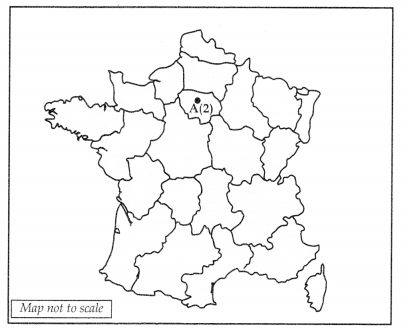
Answer:
(A)
(1) Marseilles
(2) Paris
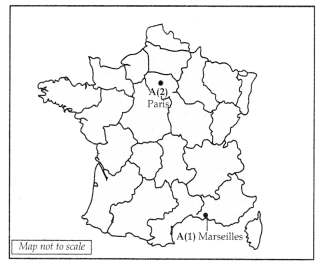
(B)
(1) On the given political map of India, locate and label the following:
(i) Tropic of Cancer
(ii) Aravalli Mountain Range
(2) A feature is marked on the political map. Identify the feature and write its name:
Outermost Range of the Himalayas.
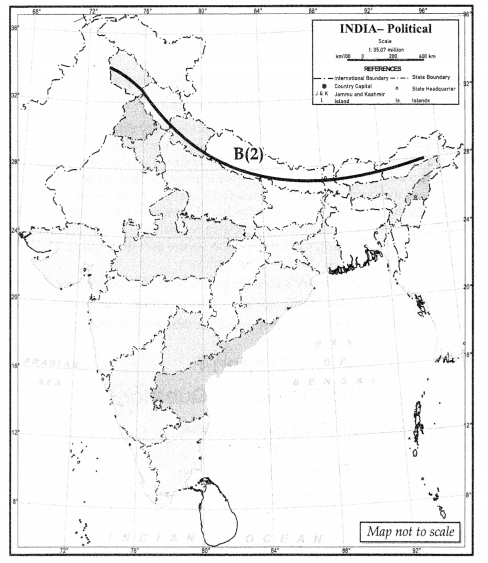
Answer:
(1)
(i) Aravali Mountain Range
(ii) Tropic of Cancer
(2) Shiwalik Range.
